Exploring Leadership Theories for 21st Century Challenges
VerifiedAdded on 2020/04/15
|11
|3529
|62
AI Summary
Leadership is crucial for achieving goals within organizations, with leaders playing a key role in inspiring others. Theories such as transformational leadership focus on vision and motivation, while transactional leadership emphasizes structure and rewards. Servant leadership prioritizes the needs of team members, and authentic leadership underscores trust and honesty. In contemporary settings, these theories are integrated to address complex challenges, emphasizing adaptability and ethical conduct. Trust is fundamental across all styles, influencing follower commitment and organizational success. Effective communication further enhances leadership by facilitating clear guidance and feedback. This assignment explores these dynamics, illustrating the diverse applications of leadership theories in modern contexts.
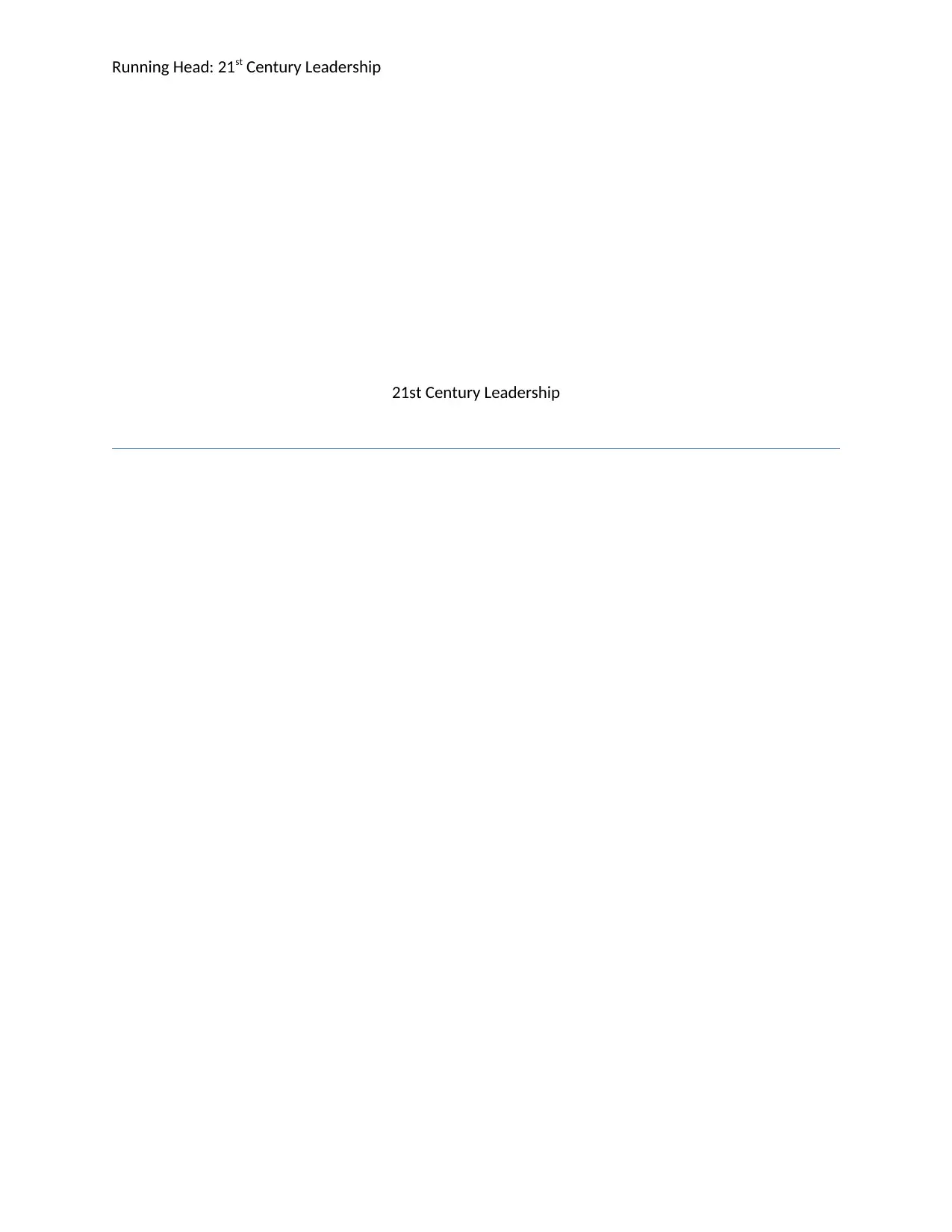
Running Head: 21st Century Leadership
21st Century Leadership
21st Century Leadership
Paraphrase This Document
Need a fresh take? Get an instant paraphrase of this document with our AI Paraphraser
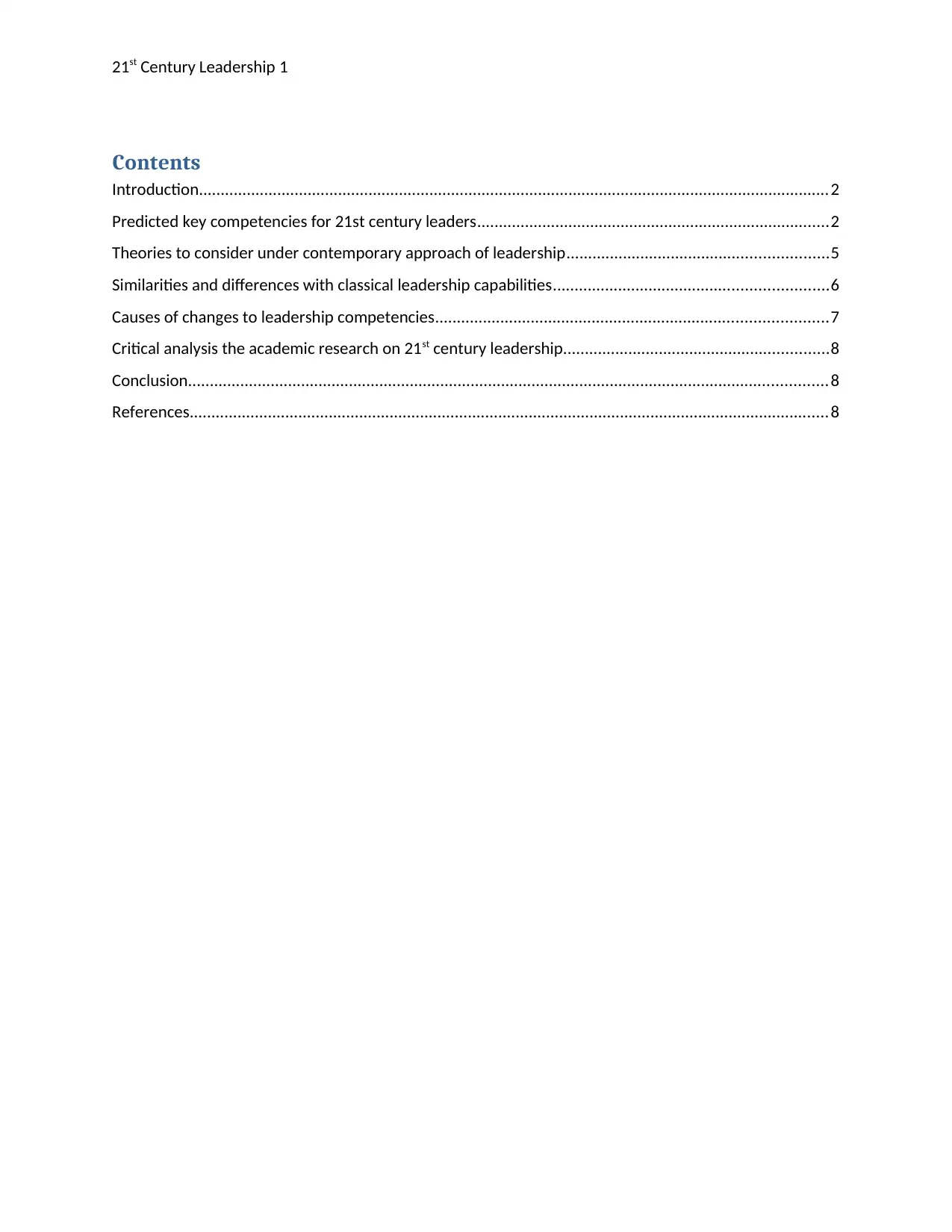
21st Century Leadership 1
Contents
Introduction.................................................................................................................................................2
Predicted key competencies for 21st century leaders.................................................................................2
Theories to consider under contemporary approach of leadership............................................................5
Similarities and differences with classical leadership capabilities...............................................................6
Causes of changes to leadership competencies..........................................................................................7
Critical analysis the academic research on 21st century leadership.............................................................8
Conclusion...................................................................................................................................................8
References...................................................................................................................................................8
Contents
Introduction.................................................................................................................................................2
Predicted key competencies for 21st century leaders.................................................................................2
Theories to consider under contemporary approach of leadership............................................................5
Similarities and differences with classical leadership capabilities...............................................................6
Causes of changes to leadership competencies..........................................................................................7
Critical analysis the academic research on 21st century leadership.............................................................8
Conclusion...................................................................................................................................................8
References...................................................................................................................................................8
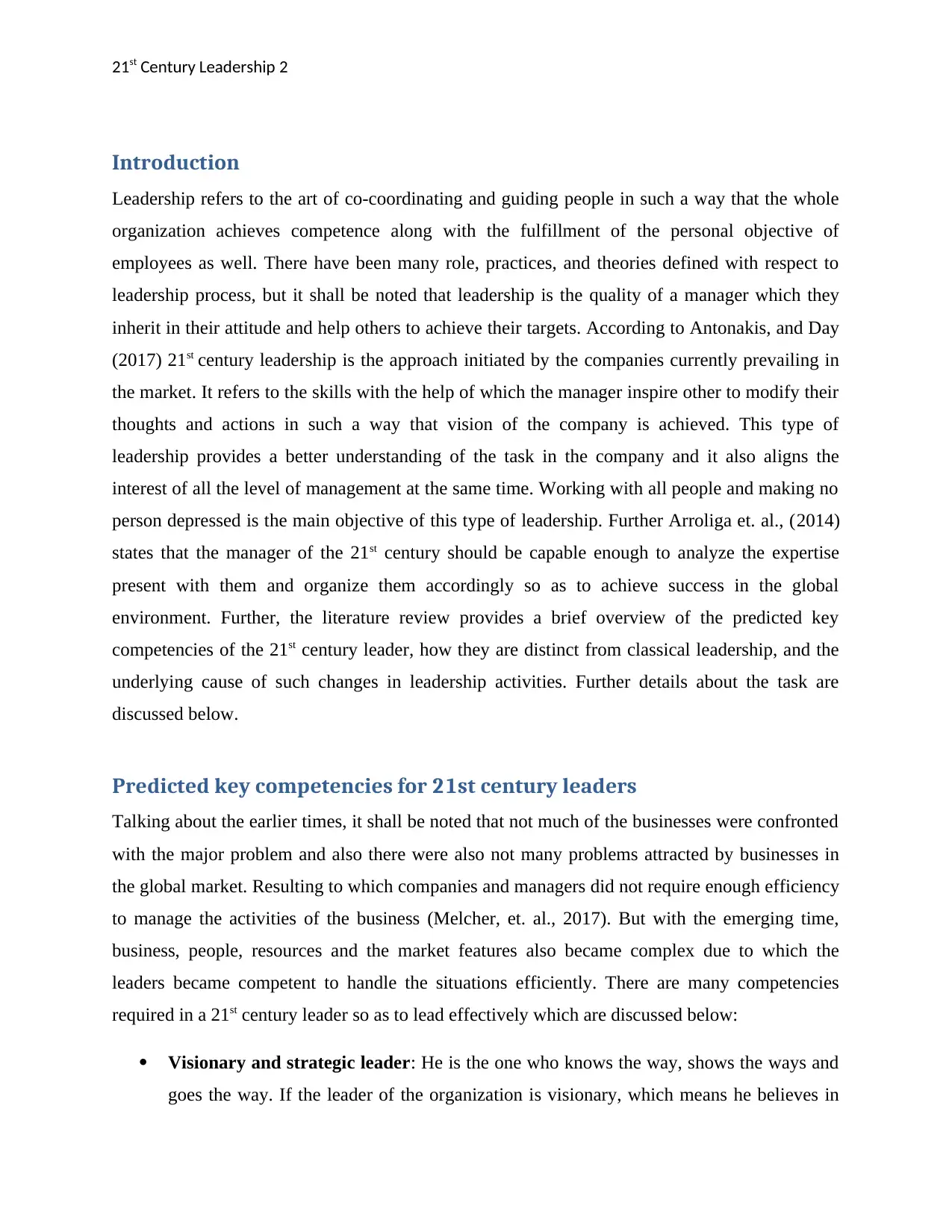
21st Century Leadership 2
Introduction
Leadership refers to the art of co-coordinating and guiding people in such a way that the whole
organization achieves competence along with the fulfillment of the personal objective of
employees as well. There have been many role, practices, and theories defined with respect to
leadership process, but it shall be noted that leadership is the quality of a manager which they
inherit in their attitude and help others to achieve their targets. According to Antonakis, and Day
(2017) 21st century leadership is the approach initiated by the companies currently prevailing in
the market. It refers to the skills with the help of which the manager inspire other to modify their
thoughts and actions in such a way that vision of the company is achieved. This type of
leadership provides a better understanding of the task in the company and it also aligns the
interest of all the level of management at the same time. Working with all people and making no
person depressed is the main objective of this type of leadership. Further Arroliga et. al., (2014)
states that the manager of the 21st century should be capable enough to analyze the expertise
present with them and organize them accordingly so as to achieve success in the global
environment. Further, the literature review provides a brief overview of the predicted key
competencies of the 21st century leader, how they are distinct from classical leadership, and the
underlying cause of such changes in leadership activities. Further details about the task are
discussed below.
Predicted key competencies for 21st century leaders
Talking about the earlier times, it shall be noted that not much of the businesses were confronted
with the major problem and also there were also not many problems attracted by businesses in
the global market. Resulting to which companies and managers did not require enough efficiency
to manage the activities of the business (Melcher, et. al., 2017). But with the emerging time,
business, people, resources and the market features also became complex due to which the
leaders became competent to handle the situations efficiently. There are many competencies
required in a 21st century leader so as to lead effectively which are discussed below:
Visionary and strategic leader: He is the one who knows the way, shows the ways and
goes the way. If the leader of the organization is visionary, which means he believes in
Introduction
Leadership refers to the art of co-coordinating and guiding people in such a way that the whole
organization achieves competence along with the fulfillment of the personal objective of
employees as well. There have been many role, practices, and theories defined with respect to
leadership process, but it shall be noted that leadership is the quality of a manager which they
inherit in their attitude and help others to achieve their targets. According to Antonakis, and Day
(2017) 21st century leadership is the approach initiated by the companies currently prevailing in
the market. It refers to the skills with the help of which the manager inspire other to modify their
thoughts and actions in such a way that vision of the company is achieved. This type of
leadership provides a better understanding of the task in the company and it also aligns the
interest of all the level of management at the same time. Working with all people and making no
person depressed is the main objective of this type of leadership. Further Arroliga et. al., (2014)
states that the manager of the 21st century should be capable enough to analyze the expertise
present with them and organize them accordingly so as to achieve success in the global
environment. Further, the literature review provides a brief overview of the predicted key
competencies of the 21st century leader, how they are distinct from classical leadership, and the
underlying cause of such changes in leadership activities. Further details about the task are
discussed below.
Predicted key competencies for 21st century leaders
Talking about the earlier times, it shall be noted that not much of the businesses were confronted
with the major problem and also there were also not many problems attracted by businesses in
the global market. Resulting to which companies and managers did not require enough efficiency
to manage the activities of the business (Melcher, et. al., 2017). But with the emerging time,
business, people, resources and the market features also became complex due to which the
leaders became competent to handle the situations efficiently. There are many competencies
required in a 21st century leader so as to lead effectively which are discussed below:
Visionary and strategic leader: He is the one who knows the way, shows the ways and
goes the way. If the leader of the organization is visionary, which means he believes in
⊘ This is a preview!⊘
Do you want full access?
Subscribe today to unlock all pages.

Trusted by 1+ million students worldwide
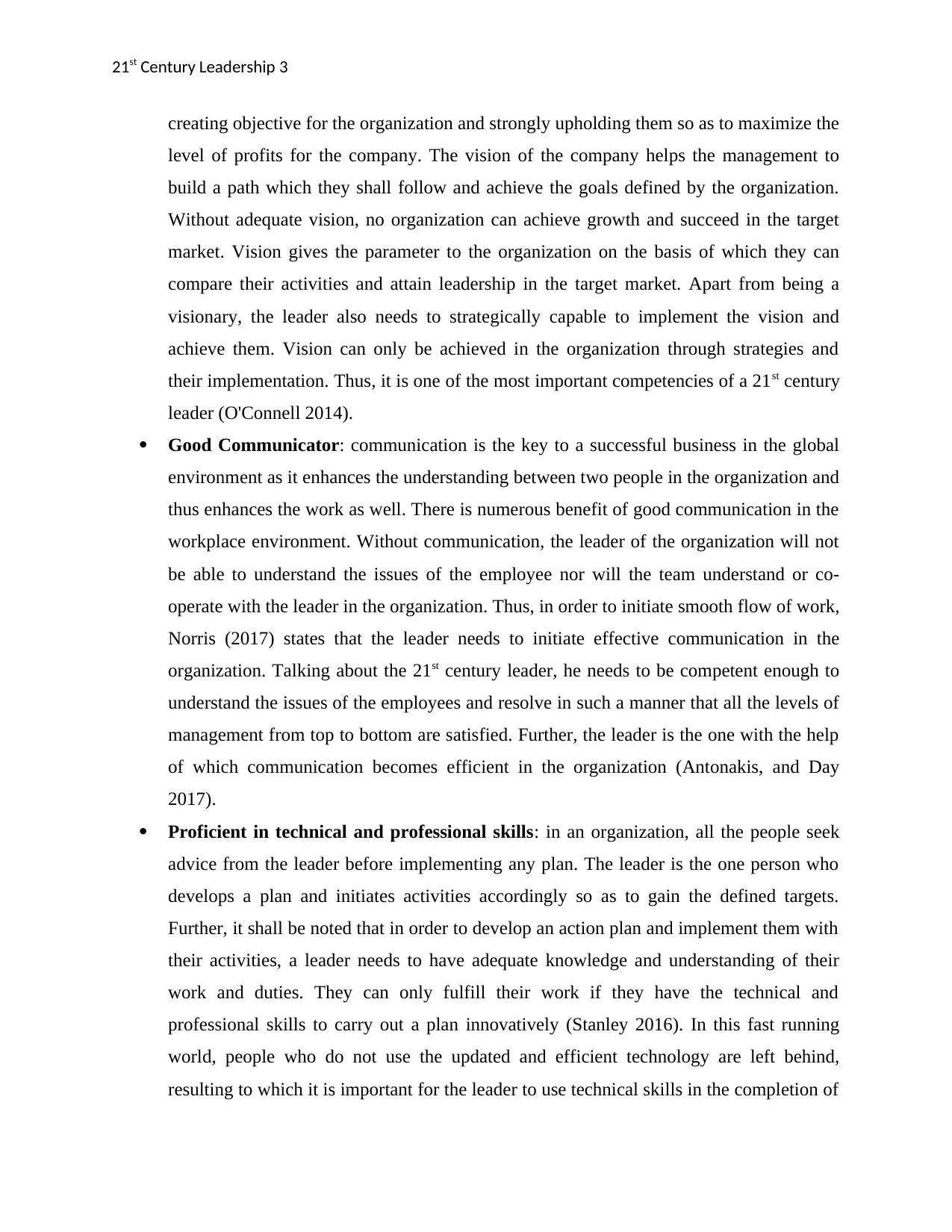
21st Century Leadership 3
creating objective for the organization and strongly upholding them so as to maximize the
level of profits for the company. The vision of the company helps the management to
build a path which they shall follow and achieve the goals defined by the organization.
Without adequate vision, no organization can achieve growth and succeed in the target
market. Vision gives the parameter to the organization on the basis of which they can
compare their activities and attain leadership in the target market. Apart from being a
visionary, the leader also needs to strategically capable to implement the vision and
achieve them. Vision can only be achieved in the organization through strategies and
their implementation. Thus, it is one of the most important competencies of a 21st century
leader (O'Connell 2014).
Good Communicator: communication is the key to a successful business in the global
environment as it enhances the understanding between two people in the organization and
thus enhances the work as well. There is numerous benefit of good communication in the
workplace environment. Without communication, the leader of the organization will not
be able to understand the issues of the employee nor will the team understand or co-
operate with the leader in the organization. Thus, in order to initiate smooth flow of work,
Norris (2017) states that the leader needs to initiate effective communication in the
organization. Talking about the 21st century leader, he needs to be competent enough to
understand the issues of the employees and resolve in such a manner that all the levels of
management from top to bottom are satisfied. Further, the leader is the one with the help
of which communication becomes efficient in the organization (Antonakis, and Day
2017).
Proficient in technical and professional skills: in an organization, all the people seek
advice from the leader before implementing any plan. The leader is the one person who
develops a plan and initiates activities accordingly so as to gain the defined targets.
Further, it shall be noted that in order to develop an action plan and implement them with
their activities, a leader needs to have adequate knowledge and understanding of their
work and duties. They can only fulfill their work if they have the technical and
professional skills to carry out a plan innovatively (Stanley 2016). In this fast running
world, people who do not use the updated and efficient technology are left behind,
resulting to which it is important for the leader to use technical skills in the completion of
creating objective for the organization and strongly upholding them so as to maximize the
level of profits for the company. The vision of the company helps the management to
build a path which they shall follow and achieve the goals defined by the organization.
Without adequate vision, no organization can achieve growth and succeed in the target
market. Vision gives the parameter to the organization on the basis of which they can
compare their activities and attain leadership in the target market. Apart from being a
visionary, the leader also needs to strategically capable to implement the vision and
achieve them. Vision can only be achieved in the organization through strategies and
their implementation. Thus, it is one of the most important competencies of a 21st century
leader (O'Connell 2014).
Good Communicator: communication is the key to a successful business in the global
environment as it enhances the understanding between two people in the organization and
thus enhances the work as well. There is numerous benefit of good communication in the
workplace environment. Without communication, the leader of the organization will not
be able to understand the issues of the employee nor will the team understand or co-
operate with the leader in the organization. Thus, in order to initiate smooth flow of work,
Norris (2017) states that the leader needs to initiate effective communication in the
organization. Talking about the 21st century leader, he needs to be competent enough to
understand the issues of the employees and resolve in such a manner that all the levels of
management from top to bottom are satisfied. Further, the leader is the one with the help
of which communication becomes efficient in the organization (Antonakis, and Day
2017).
Proficient in technical and professional skills: in an organization, all the people seek
advice from the leader before implementing any plan. The leader is the one person who
develops a plan and initiates activities accordingly so as to gain the defined targets.
Further, it shall be noted that in order to develop an action plan and implement them with
their activities, a leader needs to have adequate knowledge and understanding of their
work and duties. They can only fulfill their work if they have the technical and
professional skills to carry out a plan innovatively (Stanley 2016). In this fast running
world, people who do not use the updated and efficient technology are left behind,
resulting to which it is important for the leader to use technical skills in the completion of
Paraphrase This Document
Need a fresh take? Get an instant paraphrase of this document with our AI Paraphraser
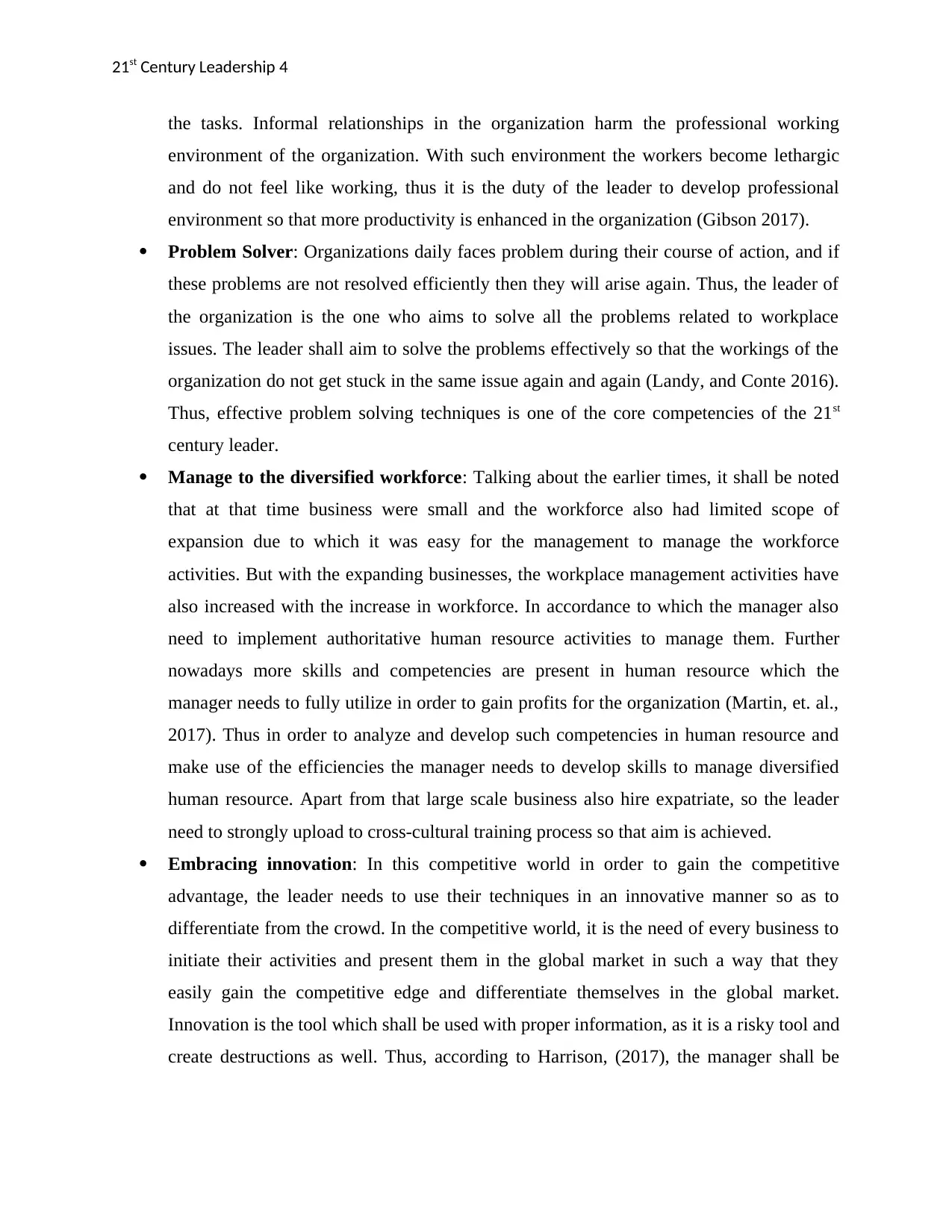
21st Century Leadership 4
the tasks. Informal relationships in the organization harm the professional working
environment of the organization. With such environment the workers become lethargic
and do not feel like working, thus it is the duty of the leader to develop professional
environment so that more productivity is enhanced in the organization (Gibson 2017).
Problem Solver: Organizations daily faces problem during their course of action, and if
these problems are not resolved efficiently then they will arise again. Thus, the leader of
the organization is the one who aims to solve all the problems related to workplace
issues. The leader shall aim to solve the problems effectively so that the workings of the
organization do not get stuck in the same issue again and again (Landy, and Conte 2016).
Thus, effective problem solving techniques is one of the core competencies of the 21st
century leader.
Manage to the diversified workforce: Talking about the earlier times, it shall be noted
that at that time business were small and the workforce also had limited scope of
expansion due to which it was easy for the management to manage the workforce
activities. But with the expanding businesses, the workplace management activities have
also increased with the increase in workforce. In accordance to which the manager also
need to implement authoritative human resource activities to manage them. Further
nowadays more skills and competencies are present in human resource which the
manager needs to fully utilize in order to gain profits for the organization (Martin, et. al.,
2017). Thus in order to analyze and develop such competencies in human resource and
make use of the efficiencies the manager needs to develop skills to manage diversified
human resource. Apart from that large scale business also hire expatriate, so the leader
need to strongly upload to cross-cultural training process so that aim is achieved.
Embracing innovation: In this competitive world in order to gain the competitive
advantage, the leader needs to use their techniques in an innovative manner so as to
differentiate from the crowd. In the competitive world, it is the need of every business to
initiate their activities and present them in the global market in such a way that they
easily gain the competitive edge and differentiate themselves in the global market.
Innovation is the tool which shall be used with proper information, as it is a risky tool and
create destructions as well. Thus, according to Harrison, (2017), the manager shall be
the tasks. Informal relationships in the organization harm the professional working
environment of the organization. With such environment the workers become lethargic
and do not feel like working, thus it is the duty of the leader to develop professional
environment so that more productivity is enhanced in the organization (Gibson 2017).
Problem Solver: Organizations daily faces problem during their course of action, and if
these problems are not resolved efficiently then they will arise again. Thus, the leader of
the organization is the one who aims to solve all the problems related to workplace
issues. The leader shall aim to solve the problems effectively so that the workings of the
organization do not get stuck in the same issue again and again (Landy, and Conte 2016).
Thus, effective problem solving techniques is one of the core competencies of the 21st
century leader.
Manage to the diversified workforce: Talking about the earlier times, it shall be noted
that at that time business were small and the workforce also had limited scope of
expansion due to which it was easy for the management to manage the workforce
activities. But with the expanding businesses, the workplace management activities have
also increased with the increase in workforce. In accordance to which the manager also
need to implement authoritative human resource activities to manage them. Further
nowadays more skills and competencies are present in human resource which the
manager needs to fully utilize in order to gain profits for the organization (Martin, et. al.,
2017). Thus in order to analyze and develop such competencies in human resource and
make use of the efficiencies the manager needs to develop skills to manage diversified
human resource. Apart from that large scale business also hire expatriate, so the leader
need to strongly upload to cross-cultural training process so that aim is achieved.
Embracing innovation: In this competitive world in order to gain the competitive
advantage, the leader needs to use their techniques in an innovative manner so as to
differentiate from the crowd. In the competitive world, it is the need of every business to
initiate their activities and present them in the global market in such a way that they
easily gain the competitive edge and differentiate themselves in the global market.
Innovation is the tool which shall be used with proper information, as it is a risky tool and
create destructions as well. Thus, according to Harrison, (2017), the manager shall be
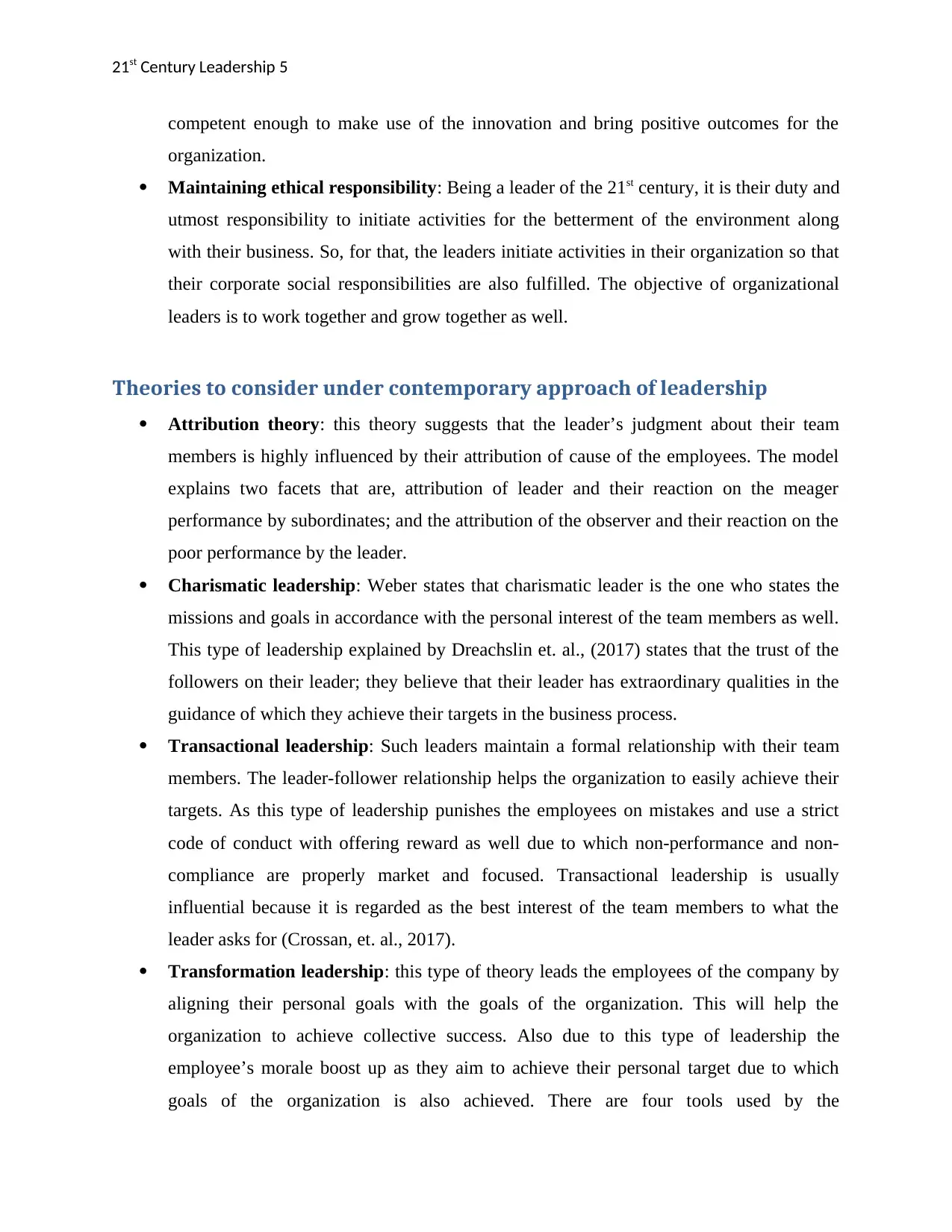
21st Century Leadership 5
competent enough to make use of the innovation and bring positive outcomes for the
organization.
Maintaining ethical responsibility: Being a leader of the 21st century, it is their duty and
utmost responsibility to initiate activities for the betterment of the environment along
with their business. So, for that, the leaders initiate activities in their organization so that
their corporate social responsibilities are also fulfilled. The objective of organizational
leaders is to work together and grow together as well.
Theories to consider under contemporary approach of leadership
Attribution theory: this theory suggests that the leader’s judgment about their team
members is highly influenced by their attribution of cause of the employees. The model
explains two facets that are, attribution of leader and their reaction on the meager
performance by subordinates; and the attribution of the observer and their reaction on the
poor performance by the leader.
Charismatic leadership: Weber states that charismatic leader is the one who states the
missions and goals in accordance with the personal interest of the team members as well.
This type of leadership explained by Dreachslin et. al., (2017) states that the trust of the
followers on their leader; they believe that their leader has extraordinary qualities in the
guidance of which they achieve their targets in the business process.
Transactional leadership: Such leaders maintain a formal relationship with their team
members. The leader-follower relationship helps the organization to easily achieve their
targets. As this type of leadership punishes the employees on mistakes and use a strict
code of conduct with offering reward as well due to which non-performance and non-
compliance are properly market and focused. Transactional leadership is usually
influential because it is regarded as the best interest of the team members to what the
leader asks for (Crossan, et. al., 2017).
Transformation leadership: this type of theory leads the employees of the company by
aligning their personal goals with the goals of the organization. This will help the
organization to achieve collective success. Also due to this type of leadership the
employee’s morale boost up as they aim to achieve their personal target due to which
goals of the organization is also achieved. There are four tools used by the
competent enough to make use of the innovation and bring positive outcomes for the
organization.
Maintaining ethical responsibility: Being a leader of the 21st century, it is their duty and
utmost responsibility to initiate activities for the betterment of the environment along
with their business. So, for that, the leaders initiate activities in their organization so that
their corporate social responsibilities are also fulfilled. The objective of organizational
leaders is to work together and grow together as well.
Theories to consider under contemporary approach of leadership
Attribution theory: this theory suggests that the leader’s judgment about their team
members is highly influenced by their attribution of cause of the employees. The model
explains two facets that are, attribution of leader and their reaction on the meager
performance by subordinates; and the attribution of the observer and their reaction on the
poor performance by the leader.
Charismatic leadership: Weber states that charismatic leader is the one who states the
missions and goals in accordance with the personal interest of the team members as well.
This type of leadership explained by Dreachslin et. al., (2017) states that the trust of the
followers on their leader; they believe that their leader has extraordinary qualities in the
guidance of which they achieve their targets in the business process.
Transactional leadership: Such leaders maintain a formal relationship with their team
members. The leader-follower relationship helps the organization to easily achieve their
targets. As this type of leadership punishes the employees on mistakes and use a strict
code of conduct with offering reward as well due to which non-performance and non-
compliance are properly market and focused. Transactional leadership is usually
influential because it is regarded as the best interest of the team members to what the
leader asks for (Crossan, et. al., 2017).
Transformation leadership: this type of theory leads the employees of the company by
aligning their personal goals with the goals of the organization. This will help the
organization to achieve collective success. Also due to this type of leadership the
employee’s morale boost up as they aim to achieve their personal target due to which
goals of the organization is also achieved. There are four tools used by the
⊘ This is a preview!⊘
Do you want full access?
Subscribe today to unlock all pages.

Trusted by 1+ million students worldwide
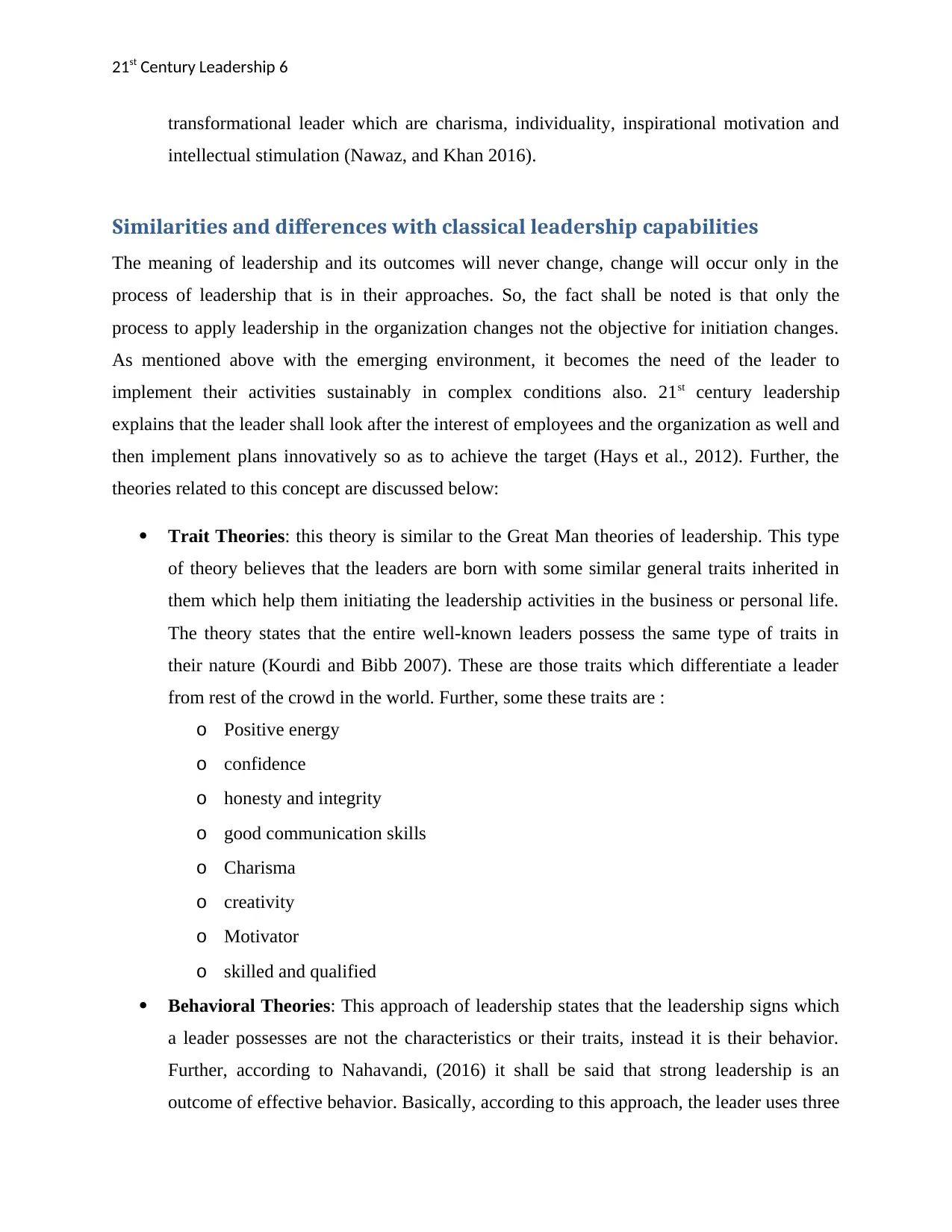
21st Century Leadership 6
transformational leader which are charisma, individuality, inspirational motivation and
intellectual stimulation (Nawaz, and Khan 2016).
Similarities and differences with classical leadership capabilities
The meaning of leadership and its outcomes will never change, change will occur only in the
process of leadership that is in their approaches. So, the fact shall be noted is that only the
process to apply leadership in the organization changes not the objective for initiation changes.
As mentioned above with the emerging environment, it becomes the need of the leader to
implement their activities sustainably in complex conditions also. 21st century leadership
explains that the leader shall look after the interest of employees and the organization as well and
then implement plans innovatively so as to achieve the target (Hays et al., 2012). Further, the
theories related to this concept are discussed below:
Trait Theories: this theory is similar to the Great Man theories of leadership. This type
of theory believes that the leaders are born with some similar general traits inherited in
them which help them initiating the leadership activities in the business or personal life.
The theory states that the entire well-known leaders possess the same type of traits in
their nature (Kourdi and Bibb 2007). These are those traits which differentiate a leader
from rest of the crowd in the world. Further, some these traits are :
o Positive energy
o confidence
o honesty and integrity
o good communication skills
o Charisma
o creativity
o Motivator
o skilled and qualified
Behavioral Theories: This approach of leadership states that the leadership signs which
a leader possesses are not the characteristics or their traits, instead it is their behavior.
Further, according to Nahavandi, (2016) it shall be said that strong leadership is an
outcome of effective behavior. Basically, according to this approach, the leader uses three
transformational leader which are charisma, individuality, inspirational motivation and
intellectual stimulation (Nawaz, and Khan 2016).
Similarities and differences with classical leadership capabilities
The meaning of leadership and its outcomes will never change, change will occur only in the
process of leadership that is in their approaches. So, the fact shall be noted is that only the
process to apply leadership in the organization changes not the objective for initiation changes.
As mentioned above with the emerging environment, it becomes the need of the leader to
implement their activities sustainably in complex conditions also. 21st century leadership
explains that the leader shall look after the interest of employees and the organization as well and
then implement plans innovatively so as to achieve the target (Hays et al., 2012). Further, the
theories related to this concept are discussed below:
Trait Theories: this theory is similar to the Great Man theories of leadership. This type
of theory believes that the leaders are born with some similar general traits inherited in
them which help them initiating the leadership activities in the business or personal life.
The theory states that the entire well-known leaders possess the same type of traits in
their nature (Kourdi and Bibb 2007). These are those traits which differentiate a leader
from rest of the crowd in the world. Further, some these traits are :
o Positive energy
o confidence
o honesty and integrity
o good communication skills
o Charisma
o creativity
o Motivator
o skilled and qualified
Behavioral Theories: This approach of leadership states that the leadership signs which
a leader possesses are not the characteristics or their traits, instead it is their behavior.
Further, according to Nahavandi, (2016) it shall be said that strong leadership is an
outcome of effective behavior. Basically, according to this approach, the leader uses three
Paraphrase This Document
Need a fresh take? Get an instant paraphrase of this document with our AI Paraphraser
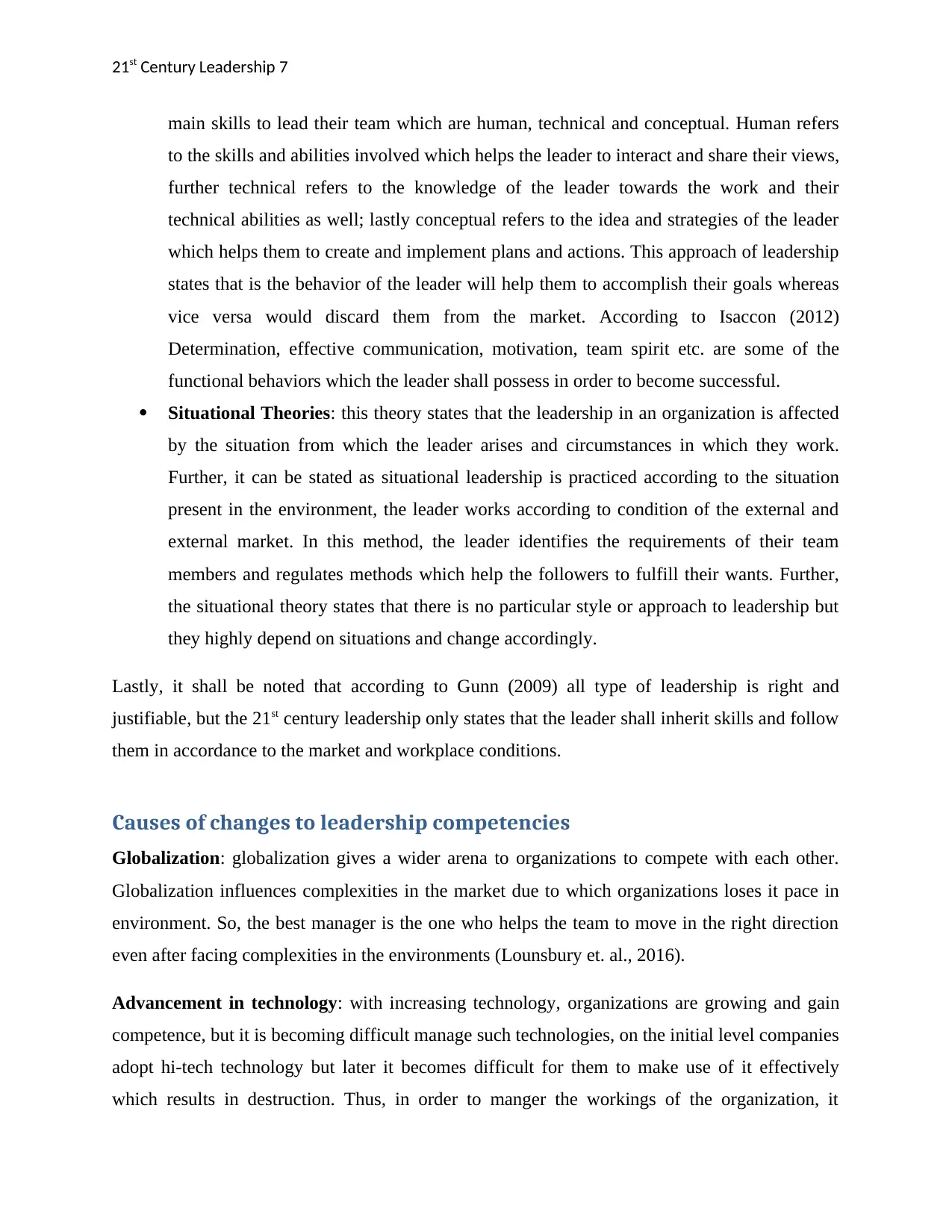
21st Century Leadership 7
main skills to lead their team which are human, technical and conceptual. Human refers
to the skills and abilities involved which helps the leader to interact and share their views,
further technical refers to the knowledge of the leader towards the work and their
technical abilities as well; lastly conceptual refers to the idea and strategies of the leader
which helps them to create and implement plans and actions. This approach of leadership
states that is the behavior of the leader will help them to accomplish their goals whereas
vice versa would discard them from the market. According to Isaccon (2012)
Determination, effective communication, motivation, team spirit etc. are some of the
functional behaviors which the leader shall possess in order to become successful.
Situational Theories: this theory states that the leadership in an organization is affected
by the situation from which the leader arises and circumstances in which they work.
Further, it can be stated as situational leadership is practiced according to the situation
present in the environment, the leader works according to condition of the external and
external market. In this method, the leader identifies the requirements of their team
members and regulates methods which help the followers to fulfill their wants. Further,
the situational theory states that there is no particular style or approach to leadership but
they highly depend on situations and change accordingly.
Lastly, it shall be noted that according to Gunn (2009) all type of leadership is right and
justifiable, but the 21st century leadership only states that the leader shall inherit skills and follow
them in accordance to the market and workplace conditions.
Causes of changes to leadership competencies
Globalization: globalization gives a wider arena to organizations to compete with each other.
Globalization influences complexities in the market due to which organizations loses it pace in
environment. So, the best manager is the one who helps the team to move in the right direction
even after facing complexities in the environments (Lounsbury et. al., 2016).
Advancement in technology: with increasing technology, organizations are growing and gain
competence, but it is becoming difficult manage such technologies, on the initial level companies
adopt hi-tech technology but later it becomes difficult for them to make use of it effectively
which results in destruction. Thus, in order to manger the workings of the organization, it
main skills to lead their team which are human, technical and conceptual. Human refers
to the skills and abilities involved which helps the leader to interact and share their views,
further technical refers to the knowledge of the leader towards the work and their
technical abilities as well; lastly conceptual refers to the idea and strategies of the leader
which helps them to create and implement plans and actions. This approach of leadership
states that is the behavior of the leader will help them to accomplish their goals whereas
vice versa would discard them from the market. According to Isaccon (2012)
Determination, effective communication, motivation, team spirit etc. are some of the
functional behaviors which the leader shall possess in order to become successful.
Situational Theories: this theory states that the leadership in an organization is affected
by the situation from which the leader arises and circumstances in which they work.
Further, it can be stated as situational leadership is practiced according to the situation
present in the environment, the leader works according to condition of the external and
external market. In this method, the leader identifies the requirements of their team
members and regulates methods which help the followers to fulfill their wants. Further,
the situational theory states that there is no particular style or approach to leadership but
they highly depend on situations and change accordingly.
Lastly, it shall be noted that according to Gunn (2009) all type of leadership is right and
justifiable, but the 21st century leadership only states that the leader shall inherit skills and follow
them in accordance to the market and workplace conditions.
Causes of changes to leadership competencies
Globalization: globalization gives a wider arena to organizations to compete with each other.
Globalization influences complexities in the market due to which organizations loses it pace in
environment. So, the best manager is the one who helps the team to move in the right direction
even after facing complexities in the environments (Lounsbury et. al., 2016).
Advancement in technology: with increasing technology, organizations are growing and gain
competence, but it is becoming difficult manage such technologies, on the initial level companies
adopt hi-tech technology but later it becomes difficult for them to make use of it effectively
which results in destruction. Thus, in order to manger the workings of the organization, it
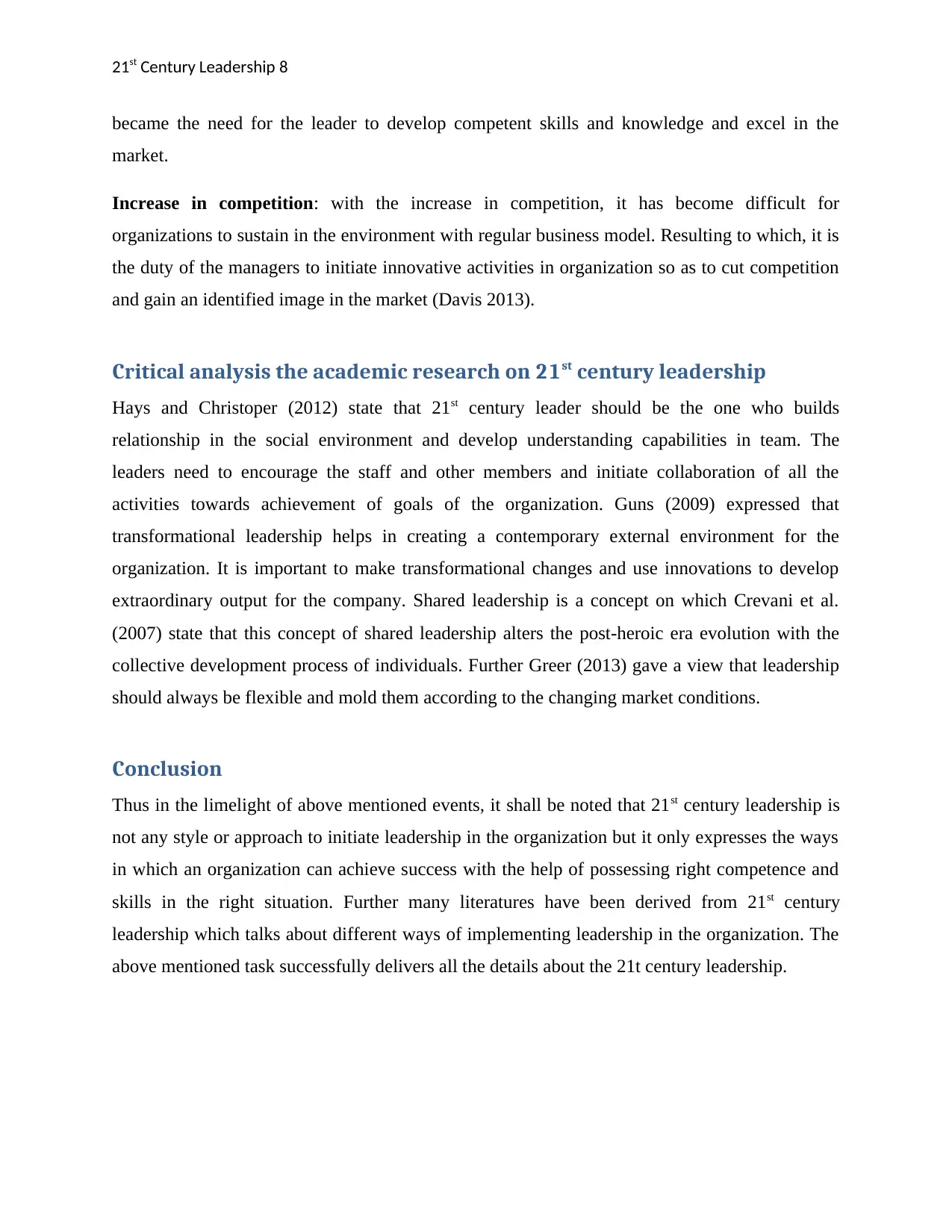
21st Century Leadership 8
became the need for the leader to develop competent skills and knowledge and excel in the
market.
Increase in competition: with the increase in competition, it has become difficult for
organizations to sustain in the environment with regular business model. Resulting to which, it is
the duty of the managers to initiate innovative activities in organization so as to cut competition
and gain an identified image in the market (Davis 2013).
Critical analysis the academic research on 21st century leadership
Hays and Christoper (2012) state that 21st century leader should be the one who builds
relationship in the social environment and develop understanding capabilities in team. The
leaders need to encourage the staff and other members and initiate collaboration of all the
activities towards achievement of goals of the organization. Guns (2009) expressed that
transformational leadership helps in creating a contemporary external environment for the
organization. It is important to make transformational changes and use innovations to develop
extraordinary output for the company. Shared leadership is a concept on which Crevani et al.
(2007) state that this concept of shared leadership alters the post-heroic era evolution with the
collective development process of individuals. Further Greer (2013) gave a view that leadership
should always be flexible and mold them according to the changing market conditions.
Conclusion
Thus in the limelight of above mentioned events, it shall be noted that 21st century leadership is
not any style or approach to initiate leadership in the organization but it only expresses the ways
in which an organization can achieve success with the help of possessing right competence and
skills in the right situation. Further many literatures have been derived from 21st century
leadership which talks about different ways of implementing leadership in the organization. The
above mentioned task successfully delivers all the details about the 21t century leadership.
became the need for the leader to develop competent skills and knowledge and excel in the
market.
Increase in competition: with the increase in competition, it has become difficult for
organizations to sustain in the environment with regular business model. Resulting to which, it is
the duty of the managers to initiate innovative activities in organization so as to cut competition
and gain an identified image in the market (Davis 2013).
Critical analysis the academic research on 21st century leadership
Hays and Christoper (2012) state that 21st century leader should be the one who builds
relationship in the social environment and develop understanding capabilities in team. The
leaders need to encourage the staff and other members and initiate collaboration of all the
activities towards achievement of goals of the organization. Guns (2009) expressed that
transformational leadership helps in creating a contemporary external environment for the
organization. It is important to make transformational changes and use innovations to develop
extraordinary output for the company. Shared leadership is a concept on which Crevani et al.
(2007) state that this concept of shared leadership alters the post-heroic era evolution with the
collective development process of individuals. Further Greer (2013) gave a view that leadership
should always be flexible and mold them according to the changing market conditions.
Conclusion
Thus in the limelight of above mentioned events, it shall be noted that 21st century leadership is
not any style or approach to initiate leadership in the organization but it only expresses the ways
in which an organization can achieve success with the help of possessing right competence and
skills in the right situation. Further many literatures have been derived from 21st century
leadership which talks about different ways of implementing leadership in the organization. The
above mentioned task successfully delivers all the details about the 21t century leadership.
⊘ This is a preview!⊘
Do you want full access?
Subscribe today to unlock all pages.

Trusted by 1+ million students worldwide
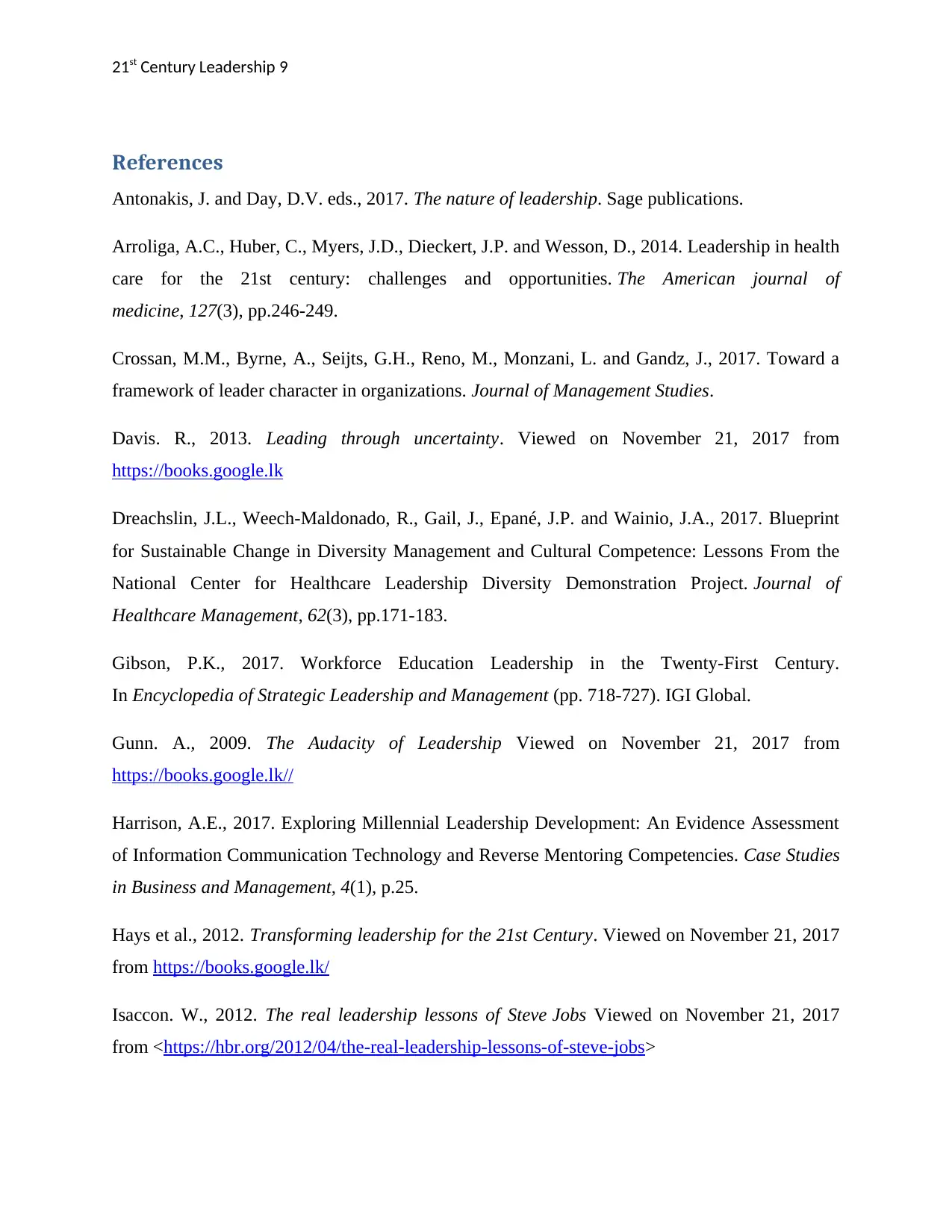
21st Century Leadership 9
References
Antonakis, J. and Day, D.V. eds., 2017. The nature of leadership. Sage publications.
Arroliga, A.C., Huber, C., Myers, J.D., Dieckert, J.P. and Wesson, D., 2014. Leadership in health
care for the 21st century: challenges and opportunities. The American journal of
medicine, 127(3), pp.246-249.
Crossan, M.M., Byrne, A., Seijts, G.H., Reno, M., Monzani, L. and Gandz, J., 2017. Toward a
framework of leader character in organizations. Journal of Management Studies.
Davis. R., 2013. Leading through uncertainty. Viewed on November 21, 2017 from
https://books.google.lk
Dreachslin, J.L., Weech-Maldonado, R., Gail, J., Epané, J.P. and Wainio, J.A., 2017. Blueprint
for Sustainable Change in Diversity Management and Cultural Competence: Lessons From the
National Center for Healthcare Leadership Diversity Demonstration Project. Journal of
Healthcare Management, 62(3), pp.171-183.
Gibson, P.K., 2017. Workforce Education Leadership in the Twenty-First Century.
In Encyclopedia of Strategic Leadership and Management (pp. 718-727). IGI Global.
Gunn. A., 2009. The Audacity of Leadership Viewed on November 21, 2017 from
https://books.google.lk//
Harrison, A.E., 2017. Exploring Millennial Leadership Development: An Evidence Assessment
of Information Communication Technology and Reverse Mentoring Competencies. Case Studies
in Business and Management, 4(1), p.25.
Hays et al., 2012. Transforming leadership for the 21st Century. Viewed on November 21, 2017
from https://books.google.lk/
Isaccon. W., 2012. The real leadership lessons of Steve Jobs Viewed on November 21, 2017
from <https://hbr.org/2012/04/the-real-leadership-lessons-of-steve-jobs>
References
Antonakis, J. and Day, D.V. eds., 2017. The nature of leadership. Sage publications.
Arroliga, A.C., Huber, C., Myers, J.D., Dieckert, J.P. and Wesson, D., 2014. Leadership in health
care for the 21st century: challenges and opportunities. The American journal of
medicine, 127(3), pp.246-249.
Crossan, M.M., Byrne, A., Seijts, G.H., Reno, M., Monzani, L. and Gandz, J., 2017. Toward a
framework of leader character in organizations. Journal of Management Studies.
Davis. R., 2013. Leading through uncertainty. Viewed on November 21, 2017 from
https://books.google.lk
Dreachslin, J.L., Weech-Maldonado, R., Gail, J., Epané, J.P. and Wainio, J.A., 2017. Blueprint
for Sustainable Change in Diversity Management and Cultural Competence: Lessons From the
National Center for Healthcare Leadership Diversity Demonstration Project. Journal of
Healthcare Management, 62(3), pp.171-183.
Gibson, P.K., 2017. Workforce Education Leadership in the Twenty-First Century.
In Encyclopedia of Strategic Leadership and Management (pp. 718-727). IGI Global.
Gunn. A., 2009. The Audacity of Leadership Viewed on November 21, 2017 from
https://books.google.lk//
Harrison, A.E., 2017. Exploring Millennial Leadership Development: An Evidence Assessment
of Information Communication Technology and Reverse Mentoring Competencies. Case Studies
in Business and Management, 4(1), p.25.
Hays et al., 2012. Transforming leadership for the 21st Century. Viewed on November 21, 2017
from https://books.google.lk/
Isaccon. W., 2012. The real leadership lessons of Steve Jobs Viewed on November 21, 2017
from <https://hbr.org/2012/04/the-real-leadership-lessons-of-steve-jobs>
Paraphrase This Document
Need a fresh take? Get an instant paraphrase of this document with our AI Paraphraser
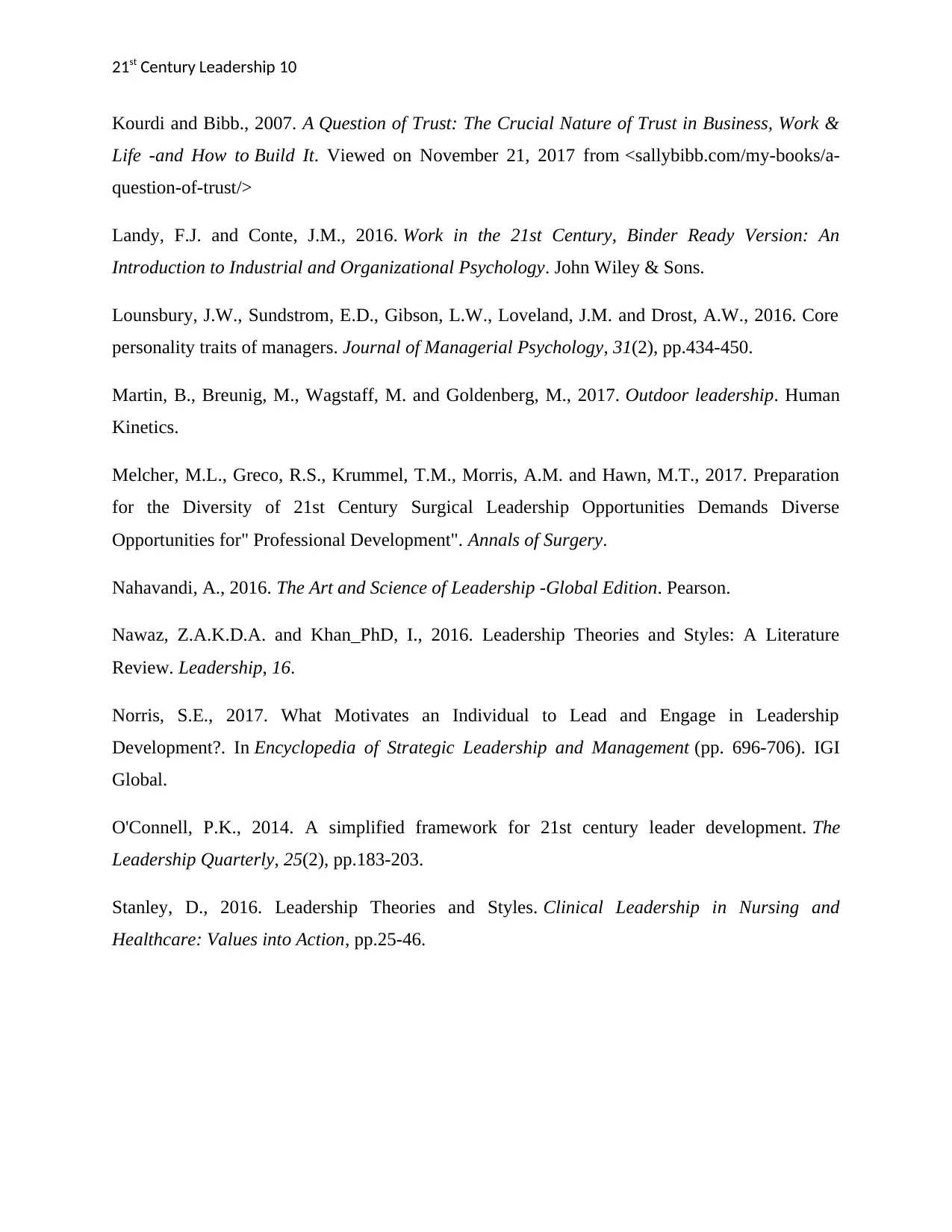
21st Century Leadership 10
Kourdi and Bibb., 2007. A Question of Trust: The Crucial Nature of Trust in Business, Work &
Life -and How to Build It. Viewed on November 21, 2017 from <sallybibb.com/my-books/a-
question-of-trust/>
Landy, F.J. and Conte, J.M., 2016. Work in the 21st Century, Binder Ready Version: An
Introduction to Industrial and Organizational Psychology. John Wiley & Sons.
Lounsbury, J.W., Sundstrom, E.D., Gibson, L.W., Loveland, J.M. and Drost, A.W., 2016. Core
personality traits of managers. Journal of Managerial Psychology, 31(2), pp.434-450.
Martin, B., Breunig, M., Wagstaff, M. and Goldenberg, M., 2017. Outdoor leadership. Human
Kinetics.
Melcher, M.L., Greco, R.S., Krummel, T.M., Morris, A.M. and Hawn, M.T., 2017. Preparation
for the Diversity of 21st Century Surgical Leadership Opportunities Demands Diverse
Opportunities for" Professional Development". Annals of Surgery.
Nahavandi, A., 2016. The Art and Science of Leadership -Global Edition. Pearson.
Nawaz, Z.A.K.D.A. and Khan_PhD, I., 2016. Leadership Theories and Styles: A Literature
Review. Leadership, 16.
Norris, S.E., 2017. What Motivates an Individual to Lead and Engage in Leadership
Development?. In Encyclopedia of Strategic Leadership and Management (pp. 696-706). IGI
Global.
O'Connell, P.K., 2014. A simplified framework for 21st century leader development. The
Leadership Quarterly, 25(2), pp.183-203.
Stanley, D., 2016. Leadership Theories and Styles. Clinical Leadership in Nursing and
Healthcare: Values into Action, pp.25-46.
Kourdi and Bibb., 2007. A Question of Trust: The Crucial Nature of Trust in Business, Work &
Life -and How to Build It. Viewed on November 21, 2017 from <sallybibb.com/my-books/a-
question-of-trust/>
Landy, F.J. and Conte, J.M., 2016. Work in the 21st Century, Binder Ready Version: An
Introduction to Industrial and Organizational Psychology. John Wiley & Sons.
Lounsbury, J.W., Sundstrom, E.D., Gibson, L.W., Loveland, J.M. and Drost, A.W., 2016. Core
personality traits of managers. Journal of Managerial Psychology, 31(2), pp.434-450.
Martin, B., Breunig, M., Wagstaff, M. and Goldenberg, M., 2017. Outdoor leadership. Human
Kinetics.
Melcher, M.L., Greco, R.S., Krummel, T.M., Morris, A.M. and Hawn, M.T., 2017. Preparation
for the Diversity of 21st Century Surgical Leadership Opportunities Demands Diverse
Opportunities for" Professional Development". Annals of Surgery.
Nahavandi, A., 2016. The Art and Science of Leadership -Global Edition. Pearson.
Nawaz, Z.A.K.D.A. and Khan_PhD, I., 2016. Leadership Theories and Styles: A Literature
Review. Leadership, 16.
Norris, S.E., 2017. What Motivates an Individual to Lead and Engage in Leadership
Development?. In Encyclopedia of Strategic Leadership and Management (pp. 696-706). IGI
Global.
O'Connell, P.K., 2014. A simplified framework for 21st century leader development. The
Leadership Quarterly, 25(2), pp.183-203.
Stanley, D., 2016. Leadership Theories and Styles. Clinical Leadership in Nursing and
Healthcare: Values into Action, pp.25-46.
1 out of 11
Related Documents
Your All-in-One AI-Powered Toolkit for Academic Success.
+13062052269
info@desklib.com
Available 24*7 on WhatsApp / Email
![[object Object]](/_next/static/media/star-bottom.7253800d.svg)
Unlock your academic potential
Copyright © 2020–2025 A2Z Services. All Rights Reserved. Developed and managed by ZUCOL.




